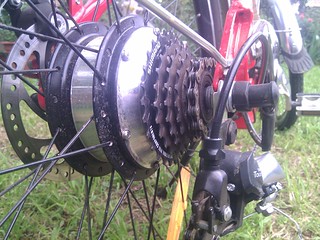I've trialled electric bikes from Switched On Cycles for a couple of weeks and the experience is good but not ideal.
 |
| Figure 1 - A bike trialled with a rear hub motor. A front wheel drive bicycle was also trialled that had a Bafang, nominally 250 watt motor powered from a 36 volt battery. |
I want a bike as close to a normal road bike as possible, that is silent, has a motor battery combination that is as light and unobtrusive as possible and doesn't run out of puff until I complete the ride. It's also apparent that whatever well planned strategies I might have for power management I behave like a junkie. My addiction, once I'm gasping for breath and the heart is pounding will cause me to abandon good intentions and seek immediate relief if all it requires is to twist the throttle.
Estimating Power Needs
Using a standard bicycle power model for a flat road and with my parameters estimated as:-| Rolling resistance Cr | 0.004 | ||||
| Air density ρ | 1.225 | [kg/m²] | |||
| Drag coefficient | 1 | ||||
| Reference area | 0.5 | [m²] | |||
| Transmission eff. | 97 | [%] | |||
| Figure 2 - My power vs speed model for a flat road and a windless day. |
From Table 1 I can average 24 km/h on a good day over a fairly flat 5.2 km section of a 36 km ride around Lake Burley Griffin which, from Figure 2 equates to about 120 watts. The estimate of reference area and drag coefficient is crude so it is probably +/- 15 watts of the true value but its close enough for some comparisons.
Rank
|
Date | Speed (km/h) |
| 1 | Nov 25, 2012 | 25.1 |
| 2 | Dec 2, 2012 | 24.8 |
| 3 | Nov 29, 2012 | 23.9 |
| 4 | Dec 16, 2012 | 23.8 |
| 5 | Nov 18, 2012 | 23.5 |
| 6 | Nov 24, 2012 | 23.2 |
| 7 | Nov 30, 2012 | 23 |
| 8 | Dec 3, 2012 | 22.9 |
| 9 | Nov 26, 2012 | 22.3 |
| 10 | Nov 23, 2012 | 22.3 |
| 11 | Nov 14, 2012 | 21.8 |
| 12 | Nov 13, 2012 | 19.6 |
The fastest rides might have benefited from a favourable breeze.
With a 500 watt motor the bike could get to 41 km/h but adding in my best average effort, would get a barely noticeable 3 km/h more. I doubt I could raise the motivation to do it. So at 500 watts I would already be riding a motorbike, albeit a dissatisfying one. It requires something like the Stealth Bomber at 4.5 kW to satisfy the power craving and by then the pedals are just for decoration. As for our reaction to artificial humans, it seems the level of satisfaction from extra power suffers an uncanny valley.
 |
| Figure 3 - Chris Horner's ride data from stage 4 of the 2011 Tour de France |
He averaged 215 watts for the whole stage, so a mere 95 watts of assist could put me in the peloton with Chris. For the final 25 km he managed 318 watts so I'd need 200 watts of assist to stick with him there but its still not much. He also managed 502 watts for 2 minutes and peaked at 710 watts. I could up the power a bit for 2 minutes too but I'd need some significant extra assist to match Chris and a 10 second sprint finish, which Chris didn't do in stage 4, would crush me. Chris also used his power more efficiently than the model for me predicts, averaging 41.6 km/h. He does this by riding most of the race on the wheel of other riders to reduce air drag and may (or may not) have had a tailwind. He also has a small cross sectional area maintained by a good pose and the small volume needed for his weight of just 64 kg, including the bike. Low weight helps hugely on the hills as well.
I'm not aiming to match Chris in all circumstances but an extra 100 - 150 watts peaking at 250 - 350 watts of silent, light weight electric power, strategically provided by an algorithm I can't abuse would put me in the ball park. Much more than that would put me well ahead of the Tour de France field but leave me dissatisfied in the uncanny valley on a gutless motorbike.
Update
I sought feedback on this article at Endless-Sphere and there was a substantial debate, which I've summarised here.NeilP spoke for many:-
and some like:-
had a different definition of low power than I'd intended.
Kraeuterbutter at viewtopic.php?f=28&t=37785#p587951 is somewhat sceptical of the power requirements of Endless Sphere aficionados.
However, there was some with plenty of experience of high power bikes who saw merit in low power bikes which I'd define as not more than 2-3 times more power than pedalling. For example:-
Some commented on the psychology of power:-
rocwandrer having never ridden an e-bike felt unqualified to add to the discussion but pointed out that:-
which is probably pretty common and my favourite version of cycling. After presenting the reasons he claims:-